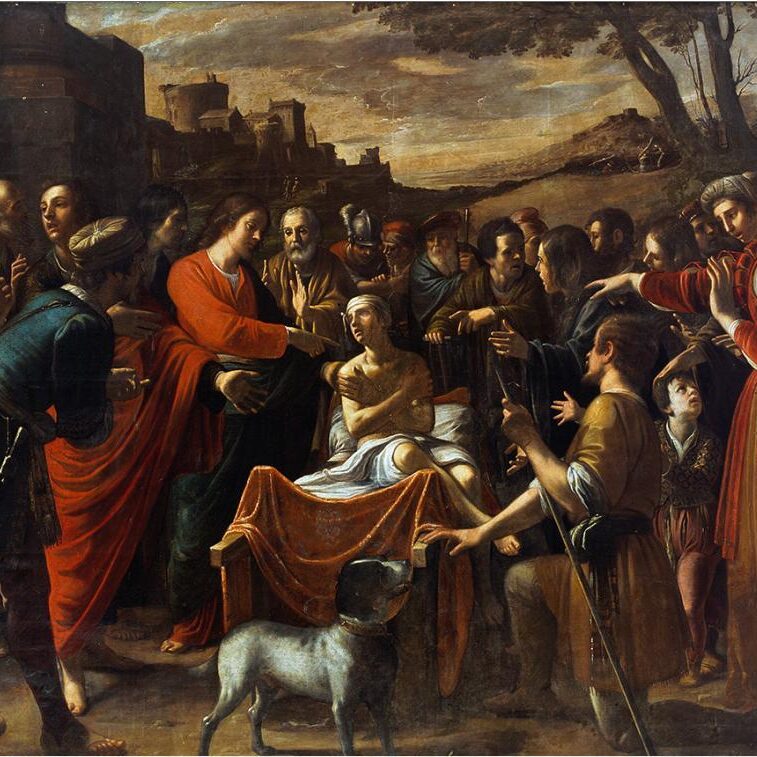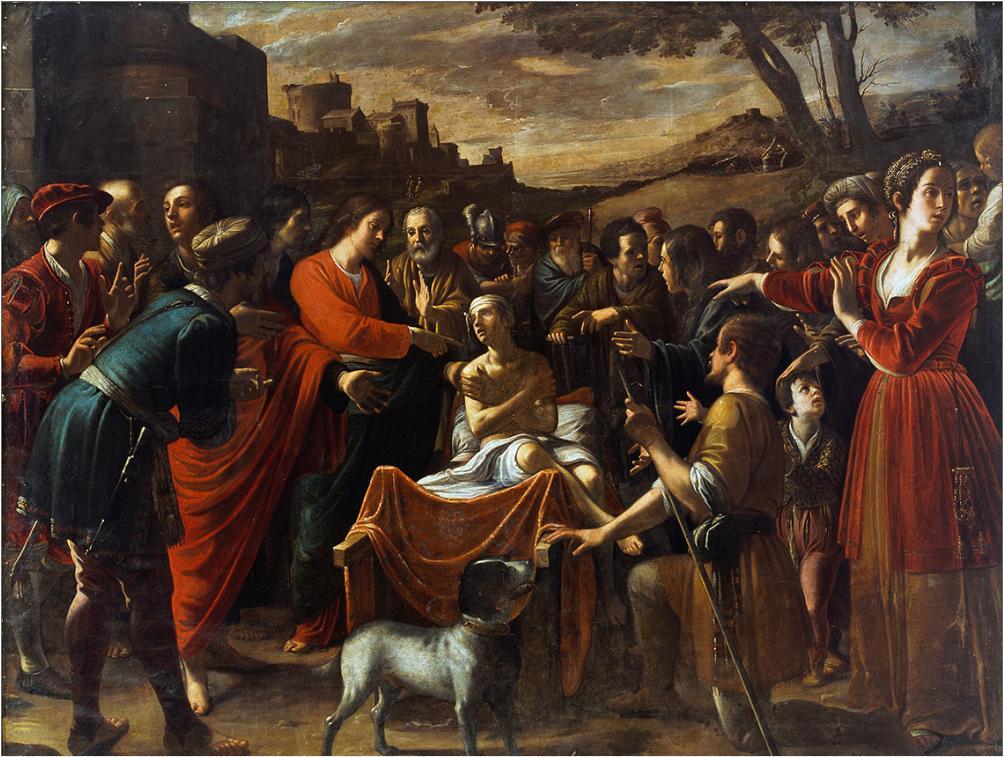Illustration from ‘The Life of Our Lord Jesus Christ’ by James Jacques Joseph Tissot
Background:
Jesus was traveling around Galilee with his disciples teaching and working miracles. He had entered into Capernum where he was sought out by a “certain centurion” whose beloved servant was on the verge of death. He asked Christ to heal him, but would not let him enter into the house saying “but that say in a word, and my servant shall be healed.” (Luke 6:7). Christ was astounded by his faith and the servant was healed, without Christ ever seeing or touching him. After performing this miracle the next day Christ and his disciples traveled to Nain (Luke 6: 10).
Facts About Her:
- She lived in Nain, a village in Galilee about 9 miles from Nazareth (vs.11);
- She was a widow (vs. 12);
- She had only one son, a young man, who had recently died. As she and “much people of the city” were taking her son out of the city on a funeral bier Christ saw her and “he had compassion on her, and said unto her, Weep not.” (vs. 12-13);
- Christ touched the bier and the men holding it stood still. Christ then commanded, ” Young man, I say unto thee, Arise” and the woman’s son arose from the dead and was “delivered” to his mother (vs. 14-15);
- After this miracle the people were afraid and declared, “That a great prophet is risen up among us” and they spread news of Christ and the miracle he had done “throughout all Judæa, and throughout all the region round about.” (vs. 17)
Speculations About Her:
- Nain is about 9 miles from Nazareth, the city where Christ grew up. In fact because Narezeth is higher in elevation one could (and possibly still could) actually see Nain from Nazareth if one looked to the southeast. In view of how close these two cities are to each other it makes me wonder if perhaps Jesus may have known this woman and her son before he saw them at the city gates. Such a thing is very possible and adds a new dimension to the story.
- In Jewish custom the dead were prepared for burial and buried very soon after death. In “Jesus and the Ossuaries: First-Century Jewish Burial Practices and the Lost Tomb of Jesus,” the authors explain that:
“When a person breathed the last breath and the heart stopped beating, the eyes of the deceased were reverentially closed, the entire body was washed and anointed with oil, and the hands and feet were then wrapped in linen bands. The body, clothed in a favorite garment, was then wrapped with winding sheets. Spices of myrrh and aloes were placed in the folds of the garment to perfume the body. A napkin was then bound from the chin to the head. The family took the body on a bier to be buried within hours of death, not days. During the first century, many people were laid to rest in rock-hewn tombs, one of the most prominent features of the hill country of Galilee and Judea; others were buried in the ground.”
We don’t know if this young man’s death was the result of long drawn out illness or an unexpected accident, but no matter how he died it is likely that his mother’s grief was fresh, very fresh. She may have only had several hours to process the fact that her only son was dead and all the implications that came along with his death. The newness of her grief makes Christ’s tender words ” weep not” all the more powerful. He was telling her that even though her grief seemed unbearable she wouldn’t have to mourn much longer because she would soon have her son again.
- As a widow with no male heir to take care of her this woman’s plight would have been hard indeed. Women had very few political rights in New Testament times and she probably would not have inherited much or been able to provide well for herself. Most likely she would have been at the mercy of other people’s charity for the rest of her life. And seeing that her son was a “young man” that probably would have been a long time for her.
My Thoughts:
I’ve been pondering a lot about the meaning of the word “compassion” and why, in many of the New Testament stories, Christ is “moved with compassion” to perform a miracle for someone. As I was studying compassion I found that compassion is not the same thing as pity, sympathy or empathy. One of the big differences is that while pity and sympathy are things that you feel, compassion is something that you do. Compassion is often linked to the word mercy and used to describe the motivation behind great acts of charity and love like the Atonement. In fact, the outward expression of charity is compassion.
It is interesting that throughout the scriptures Christ often says that his “bowels are filled with compassion” (John 3:17; D&C 101:9; 3 Ne. 17:6) towards His children. The word “bowels” in the original New Testament Greek is σπλάγχνα (splágxnon) and refers to organs of the body like the heart, lungs, intestines and the womb. All these are all parts of the body that swell and then must expel something to keep functioning properly. So when Christ says that His bowels are filled or moved with compassion he is saying that His great love, His charity, for His children compels Him to bless them, heal them and save them.

Compassion is charity in action.
The other thing I love about this woman’s story is that it is a profound testimony of Christ’s love and compassion towards women. In fact, in all four accounts we have of Jesus raising someone from the dead all of them are done in the presence of, and usually on the behalf of, women.
- The raising of the daughter of Jairus was not only performed on a woman (a girl really) but the only people there to witness it was the girl’s father and mother and two of the apostles (Luke 8:41-56).
- The raising of Lazarus from the dead was done in the presence of only a few, mainly Mary and Martha, and was done mostly on their behalf (John 12).
- When Christ rose from his grave his first witness was Mary Magdalene and the other women who came to prepare his body for burial.
- The raising of the son of the widow of Nain from the dead was done in the presence of many men and women but was on done because Christ had compassion on a woman.
Raising a person from the dead is an incredible miracle for anyone to witness, but it has special meaning for women. Christ is demonstrating to women that he has power over the grave. Giving them a living testimony that through him and by him all the children that women bear and nurture on this earth will live again. No sacrifice that women make to bring forth a child, to nurture a friend, or to love a family member will be in vain, because Christ will be (and is) victorious over death.
Questions to Think About:
- Why were “much of the people of the city” with her as she buried her son? What type of people do you think she and her son were to have so many people mourn with them?
- Do you have a widow in your life (young or old) who needs remembering? What special challenges does she face? How can you follow the example of the Savior and be moved with compassion towards her?
- Can you relate to this woman’s grief? How do you image she felt when she saw her son raised from his death bed? How does her story help you better understand the power of the atonement and the resurrection?
- What special significance does the term “compassionate service”, which is often used to describe the work the Relief Society does, have seeing that the motto of the Relief Society is “Charity Never Faileth”?



This is why I love your blog – you talk about women I never even really knew existed!
I love how you pointed out that the Savior did a lot of raising-from-the-dead on behalf of women.
I also love that you suggested that He is letting us know that our own compassion will not be in vain. Sometimes it can really feel that way.
This is not really related to death, but when I was in Young Women, one of my friends (whose parents were members, but not active, and who had been coming to church since she was 8 or 9) finally got her parents permission to be baptized. Baptisms in our small ward building were usually held in the Relief Society room, and hers started out there. However, but 5-10 minutes before the meeting was supposed to start, the Relief Society room was standing room only, and the program was moved into the chapel. I remember the feeling of love and support that came as nearly every member of the ward showed up for this young woman's baptism. I think it said as much about the ward members as it did about her.
Perhaps the same was true with the people of Nain – perhaps they truly had compassion on this woman and were there in her time of need to offer their help and assistance as she buried her son.